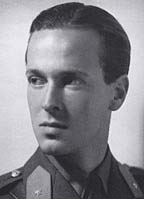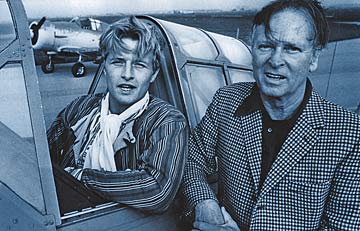 |
Soldiering On
The path to peace between Holland
and Japan runs through the Big Island
When the Second World War ended 60 years ago, the Allied nations arrayed against the empire of Japan were many. The primary combatants in the Pacific War, however, were America, China, the countries of Great Britain and Holland.
![]()

Hazelhoff in uniform during World War II
The wounds of war are healing, however -- thanks to a resident of Kamuela, on the island of Hawaii.
"It's really an extraordinary accomplishment," said Pacific War Memorial chairwoman Alice Clark. "It just shows you that one person really can help bring about peace and friendship between two countries."
Writer Erik Hazelhoff and designer wife Karin Steensma have been quietly living their retirement years in the hills of Kohala. In the Netherlands, however, Hazelhoff is something of a celebrity. "Soldier of Orange," his memoirs of adventures in the Dutch underground during the war, became the best-selling book in Dutch history and the basis of a Golden Globe-winning film of the same name. He's feted wherever he goes there, and during the past few years he's been in demand as a guest of honor at wartime commemorations around the world.
But he prefers the Big Island. "In Holland, I'm part of the past, and the past is gone," Hazelhoff said, pausing in Honolulu on his way home from an event in Canada. "They keep looking back in time. I prefer to think about the future. Once it's over, it's over. Move on!"
"Resistance fighter" is just one line on his resume. Hazelhoff also spent time as a travel writer, freight-hopping hobo -- he crossed America in 1938 just to keep a date with a girl in Sausalito -- Argentine gaucho, law school graduate, Hollywood actor, clothing salesman, Royal Air Force fighter pilot ("The DeHavilland Mosquito is the most beautiful plane ever designed. She never let me down!"), aide-de-camp to the royal family of Holland, Moluccan rebel smuggler, director of Radio Free Europe and occasional carpenter for his wife's interior designs at the Watergate in Washington, D.C.
He is forever linked to "Soldier of Orange," however, and that is how he got involved in the nascent peace process between Japan and Holland.
"When Commodore Perry anchored in Tokyo Bay, the local officials greeted him in Dutch," Hazelhoff explained, sitting across a Waikiki hotel table. "It was the only foreign language known to the Japanese, because the Dutch had already been there for more than 200 years. There were historic ties of friendship and trade between Japan and Holland. Until World War II ...
"The islands of the Netherlands East Indies -- now Indonesia -- had something like 300,000 Dutch citizens in the colony there. When the Japanese thundered in from Malaysia in 1942, the Dutch civilians were put in prison or construction camps in Burma, and many thousands died."

Actor Rutger Hauer and Erik Hazelhoff during the filming of "Soldier of Orange," about Hazelhoff's wartime exploits.
"When Hirohito made a good-will visit through Europe many years later, only Holland closed its borders. The Dutch have long memories."
In the 1980s, Prince Willem-Alexander of the House of Orange made a private visit to Japan. On his return to Holland, he had dinner with family friend Hazelhoff and expressed dismay about the cold diplomatic barrier between the two countries.
"He said, 'The crown prince of Japan doesn't even know about the camps! Nice guy, but I had to tell him about it. We got along for 300 years, we should get along again. We've got to DO something!'"
A decade ago, Hazelhoff remembered the prince's conundrum when another friend, University of Hawaii Japanese history professor Reyn Hesselink, asked Hazelhoff if he could persuade the prince to attend a commemoration of the 350th anniversary of contact between the two countries to be held in the Japanese town of Yamada.
There wasn't a chance the Prince of Orange would pay an official visit, given the still-standing ill will. But Hazelhoff had an idea.
"Tell your friends in Yamada that the Prince of Orange is otherwise engaged," he told Hesselink. "But you can deliver the Soldier of Orange, and he's just as good for the party."
The Yamada authorities fell for the switch, thanks to education director Teiroh Kimura, and the Hazelhoffs and Hesselink were invited as Dutch representatives, the first since before World War II.
Hazelhoff checked in with Netherlands Prime Minister Ruud Lubbers and got his backing in the form of Far East diplomat Roland van den Berg as liaison. Van den Berg and wife Mieke joined the party in Yamada, and for a week they "practiced good will and foreign relations," said Hazelhoff. "We ate and drank, visited meetings and public events, held speeches and planted friendship trees."
Having Van den Berg along saved the day.
"My stature amongst our hosts had slipped badly, because after establishing that the Soldier of Orange was nowhere related to the House of Orange, they were at a loss where to place me, both in their estimation and in practical protocol. One night after a dinner we had to put our shoes back on and Roland -- veteran diplomat! -- saw his chance. He pushed me onto a bench and personally tied my shoes. Our hosts were flabbergasted. From that moment on, my prestige was unassailable. We're very lucky it went well."
When the time came to leave, Hazelhoff thanked Kimura for their hospitality and asked if there was anything the Dutch could do in return.
"Yes," said Kimura. "You can send us a football team." There was a sports extravaganza planned for the next year, and Kimura thought it would be nice if a team of Dutch teenagers participated.
As it happened, Hazelhoff had played in a Dutch soccer club before the war, and it was still in existence. They fielded a team of kids who were welcomed in Yamada, and the year after that, even more Japanese soccer players were welcomed to the town of Zeist, "in the heart of the Netherlands, which is larger than Yamada but not by much, and as luck would have it, the director of education is Fred Steensma, a cousin of my wife," said Hazelhoff.
"He's the Dutch version of Dr. Kimura, and together, they've set up a student exchange program that grows every year."
Clark said that small steps like these can lead nations on a friendly path. "What Erik Hazelhoff has done is help break the ice that has built up between Japan and Holland since the war," she said.
Last year, the townships of Zeist and Yamada officially became sister cities, said Hazelhoff, and the Dutch queen has paid an official visit to Japan. "Nations struggle to make peace prevail on Earth -- it can be done!"
[News] [Business] [Features] [Sports] [Editorial] [Do It Electric!]
[Classified Ads] [Search] [Subscribe] [Info] [Letter to Editor]
[Feedback]
